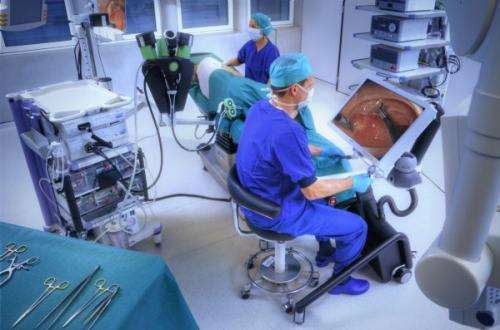Robotic flexible endoscope kinder to doctor, patient and finances

This is a flexible endoscope which can be operated by one person, instead of by two or three, as is often the case with the current endoscopes. PhD candidate in Industrial Design, Jeroen Ruiter, University of Twente, designed this endoscope along with technology provider DEMCON. With the flexible robotic endoscope, doctors will eventually be able to perform complex surgeries through natural orifices, without external scars. The patient recovers faster and the hospitalization time is shorter, saving healthcare costs.
The standard endoscope, a flexible hose with a controllable camera, which is used today in hospitals, is a mechanical tool. In surgery, it is often operated by two or three persons. The new flexible robotic endoscope can be operated independently by a single doctor. When doing this, he has full control of the endoscope and he feels how the device interacts with the patient. Procedures will then be performed faster and be less stressful. An additional advantage is that doctors will be able to master the procedure much more quickly than is the case with the present endoscope. Moreover, specialist nurses could also be trained to perform diagnostic tasks independently. This year, the mass screening program for colorectal cancer is being introduced in the Netherlands. Jeroen Ruiter: "There is a great shortage of hands to carry out that screening. Possibly, a user-friendly and efficient steering system could relieve this pressure."
Surgical procedures
Surgical procedures that doctors now carry out via external incisions could be performed using the robotic flexible endoscope through natural orifices and without external scars. The procedure is less invasive for patients, both mentally and physically. This patient recovers faster and the hospitalization time is reduced, saving healthcare costs. Jeroen Ruiter: "One example is the removal of a large tumor on the intestinal wall. At this time, a patient is often referred to surgery for the removal of a part of the intestine. With our system, the tumor can be dissected from the inside, whereby the intestine recovers completely. This can be standard practice in five years." The guiding of the new endoscope is user friendly and intuitive. The physician experiences the working of it as the direct handling of instruments, just as in open surgery. Ruiter: "With our system, the physician is also able to make a suture. This is an action that is unthinkable with the current flexible instruments."
In the long run, the system can also be used to treat organs outside the digestive tract. To do this, however, the intestine must be perforated. Further medical and technical research is needed to ensure sterility in the surgical field. Another possibility for the future the introduction of smart software. This could, for example, during insertion of the tube, provide for automatic steering to the center of the intestine on the basis of the camera images. Or, the software could compensate for patient movement, such as the breathing, in precise surgical procedures.
Jeroen Ruiter will hold his doctoral defense on 6 September 2013. He carried out his doctoral research at the Department of Design, Production and Management of the Faculty of Engineering Technology at the University of Twente and at DEMCON. His supervisors are Prof. Fred van Houten and Prof. Ivo Broeders, his assistant supervisors are Dr. Mascha van der Voort and Dr. Maarten Bonnema.















